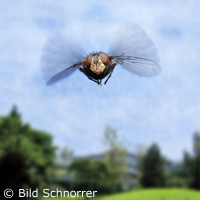Scientists discover what makes flies fly
Scientists in Austria and Germany have discovered a genetic switch that regulates the formation of flight muscles in flies, creatures with very small wings in relation to their bodies. The study, published in the journal Nature, suggests that spalt proteins switch myofibres from tubular to fibrillar fate during development. This function is potentially conserved in the heart of vertebrates: the stretch-stimulated muscle resembles the muscle used for insect flight. Led by the Max Planck Institute (MPI) of Biochemistry in Germany, researchers say the gene spalt plays an instrumental role in the production of ultrafast super muscles. 'Without spalt, the fly builds only normal leg muscles instead of flight muscles,' says Frank Schnorrer from the MPI of Biochemistry, one of the authors of the study. To ensure efficient flying, flies must quickly flap their tiny wings. The familiar buzzing and humming we hear is a result of this movement. The fruit fly Drosophila melanogaster moves its wings at a frequency of 200 hertz: its flight muscles contract and relax 200 times per second. 'In contrast, a 100-metres sprinter who moves his legs only a few times per second moves like a snail,' says Dr Schnorrer, head of the Muscle Dynamics group at MPI of Bioinformatics. The question, is, how can the fruit fly flap its wings at such a high frequency? The researchers explain how muscles control all body movements, including the wing oscillations. But there is a uniqueness to flight muscles. While nerve impulses regulate the fly's contractions, tension stimulates the contractions as well. There are two categories of flight muscles in each fly, and each enables the wing oscillations. One type moves the wings down and stretches the other type, which triggers their contraction. So the fly's wings are pulled up again, and stable wing oscillations commence. Lack of spalt makes flying impossible. Transcription factors like spalt are crucial for ensuring the correct transcription of the genetic information into ribonucleic acid (RNA) and proteins necessary in the respective cell type. Spalt only exists in flight muscles and is responsible for the specific architecture of their myofibrils, say the researchers, adding that these components of muscle fibres alone contribute to triggering the contraction of a muscle in response to the applied tension during the oscillations. While flies will survive without spalt, they cannot fly. The flight muscles no longer react to tension, and behave like normal leg muscles. However, the scientists successfully created flight muscle-like muscles in flies' legs after inserting spalt. The team says the results could prove significant for the medical sector. 'Human body muscles do not have spalt and are hardly regulated by tension,' Dr Schnorrer explains. 'But the human cardiac muscle builds spalt and the tension inside the ventricle influences the heartbeat intensity. Whether spalt plays a role in heartbeat regulation is not yet known and remains to be investigated.'For more information, please visit:MPI of Biochemistry:http://www.biochem.mpg.de/en/index.htmlNature:http://www.nature.com/nature/index.html
Countries
Germany



